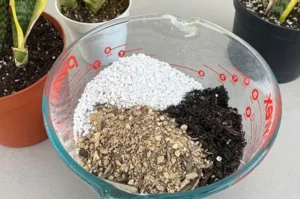Snake plants, also known as Sansevieria or mother-in-law’s tongue, are one of the most resilient houseplants. However, like all plants, they need a bit of extra care during winter. When temperatures drop, their growth slows down, and improper conditions can lead to yellowing leaves, root rot, or even death.
In this guide, we’ll walk you through simple yet essential winter care tips for your snake plant to ensure it survives the cold season and thrives when spring arrives.
Why Winter Care Is Important for Snake Plants
Snake plants are native to tropical West Africa, where the climate is warm and dry. Winter’s cold temperatures and reduced light can stress the plant if you’re not careful. Proper winter care helps:
- Prevent overwatering and root rot
- Maintain healthy leaves
- Avoid cold damage
- Prepare your plant for a strong spring rebound
1. Reduce Watering in Winter
How Often Should You Water in Winter?
In warmer months, snake plants need watering every 2–3 weeks. But in winter, the plant enters a dormant phase and doesn’t need as much water. Overwatering during this time is the most common mistake.
Winter Watering Tips:
- Water only once every 4–6 weeks
- Always check the top 2 inches of soil; if it’s dry, then water
- Use a pot with drainage holes to avoid soggy soil
Too much moisture can cause root rot, especially in cold conditions. Less is more when it comes to watering in winter.
2. Keep It Warm and Cozy
Snake plants don’t tolerate cold drafts or temperatures below 50°F (10°C). Keeping them in a warm room away from cold windows is essential.
Ideal Conditions:
- Temperature: 60–80°F (15–27°C)
- Away from heaters or vents (too much dry air can also cause damage)
- Avoid placing near drafty doors or windows
If needed, use a room thermometer to monitor the temperature around your plant.
3. Maximize Sunlight Exposure
Winter days are shorter, and snake plants need as much light as they can get. They love indirect bright light but can tolerate lower light levels. However, low light combined with overwatering can be harmful.
Light Tips:
- Move the plant closer to a south- or west-facing window
- Clean the dust off the leaves to improve light absorption
- Use a grow light if natural light is limited
Avoid direct sunlight, which can scorch the leaves even in winter if it’s too strong.
4. Don’t Fertilize During Winter
Snake plants grow slowly in winter and don’t need extra nutrients. Fertilizing now can overwhelm the plant and cause salt buildup in the soil.
Fertilizing Rule:
Skip fertilizers from late fall to early spring.
You can resume feeding your plant with a balanced houseplant fertilizer once new growth appears in spring.
5. Avoid Repotting or Propagation
Winter is not the time to repot or propagate your snake plant. The roots are less active, and the plant is focused on surviving, not growing.
Why You Should Wait:
- Repotting can stress the plant
- Cuttings take longer to root in cold conditions
- Spring and summer are ideal for repotting and propagation
Unless it’s an emergency (like root rot), wait until the weather warms up.
6. Watch for Common Winter Problems
Despite being tough, snake plants can face issues in winter. Here’s what to look out for:
| Problem | Possible Cause | Solution |
| Yellow or mushy leaves | Overwatering | Cut back on water, trim damaged leaves |
| Wrinkled or droopy leaves | Underwatering or cold stress | Slightly increase water or move to a warmer spot |
| Brown leaf tips | Dry air or too much heat | Use a humidifier or move away from heater |
Being proactive helps your plant avoid damage and stay healthy.
Frequently Asked Questions
Should I mist my snake plant in winter?
No, misting is not necessary for snake plants. They prefer dry air, and misting can lead to excess moisture, encouraging fungal issues or rot.
Can I keep my snake plant near a window in winter?
Yes, but make sure the window doesn’t let in cold drafts. If the window sill gets too cold at night, move the plant back a bit or use thermal curtains.
What happens if I overwater my snake plant in winter?
Overwatering is one of the main causes of root rot. In winter, soil takes longer to dry, so excess water sits in the pot, damaging the roots. If you notice mushy or yellow leaves, reduce watering and check the roots immediately.
My snake plant stopped growing in winter. Is that normal?
Yes, it’s completely normal. Snake plants go dormant during winter. Growth will resume in spring when the temperatures rise and daylight increases.
Can snake plants survive a power outage during freezing temperatures?
Snake plants cannot tolerate frost. If your home becomes very cold (below 40°F or 4°C), bring the plant to the warmest room, wrap the pot in a towel, or place it near other warm objects to help retain heat temporarily.
Conclusion
Snake plants are low-maintenance and forgiving, but they still need seasonal adjustments to thrive, especially in winter. By reducing water, keeping the temperature consistent, maximizing light, and avoiding stressors like fertilizer or repotting, you can help your snake plant survive the winter months easily.
Come spring, your plant will thank you with fresh new growth and lush, green leaves!






